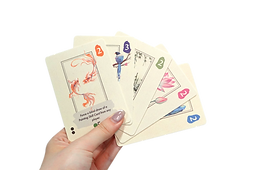
Destiny
Destiny is a strategic board game where players embody aspiring painters n the field of traditional Chinese art. As they gather resources and refine their skills, they master the use of ink tokens to shape their artistic destiny. Each strategic decision impacts their place in history, determining whether they rise to become famous masters or wander at critical crossroads, their fate shaped by wisdom and courage.
Playtime: 30-60 minutes
Players: 2-4
Age: 12+
Type: Family Game
Game Overview
Goals of players
- Achieve Skills: Collect painting skill cards to elevate painting skill and gain reputation.
- Optimize Resources: Manage ink tokens and seal tokens effectively to gain painting skills.
- Make Strategic Choices: Use events and the Destiny Dice to navigate risks and shape the path.
- Gain Reputation: Compete for the highest reputation to be remembered as a master artist.

5 Types of Ink Tokens (10 each):
-
-
Fish - Orange
-
Mountain - Blue
-
Bamboo - Green
-
Flower - Pink
-
Bird - Purple
-
-
Level 1 Cards (6 x 5)
-
Level 2 Cards (4 x 5)
-
Level 3 Cards (3 x 5)
-
Destiny Dice
-
Painting Skill Cards:
-
Level 1 x 30
-
Level 2 x 20
-
Level 3 x 15
-
-
Chinese Seal Tokens (8)

Components
Rulebook

Component Design
Painting Skill Cards represent the painting skills that players upgrade in the game. As the level of the cards upgrades, the player's painting skills increase.
Painting Skill Card

Event
Players can trigger events on their acquired painting skill cards to gain additional resources or disrupt other players‘ resources.
Card Level Sign

The number of ink drops represents the card level, the first level card has one dot, and so on.
Painting Skill Point
Represents the player's painting skill value after obtaining the card.
When the skill value reaches 10, the player wins.
Ink Token Requirements
Can get the corresponding painting skill card through the corresponding ink token value requirements.

Level 3 Cards
Only Level 3 Skill Cards have the "命" sign.

To trigger the Destiny Dice, players must spend one Chinese seal token.

Chinese seal token
Wildcard for game resources.
Can be used for any type of ink token.
Destiny Dice
Opportunity to fight for "Destiny", different sides represent different meanings.
Five Types of Ink Tokens (10 each):
Ink tokens are game resources, which can exchange for painting skill cards. Players can gain different ink tokens through blind drawing in the cloth bag or through card events.

Core Machenics
It is very important to flexibly collect and use ink tokens and Chinese seal tokens (wildcards), so that players can effectively manage resources in the game and increase the driving force of each round.
Resource Gathering

Strategic Choices
Each round, players need to decide whether to exchange a painting skill card or trigger an event, or trigger the destiny dice to get a random result. All choices will create different destinies, keeping players engaged and adding depth to each round.

By exchanging for higher-level painting skill cards, players can clearly feel the sense of progress and challenge, providing players with a tangible feeling of constantly improving their painting skills and status in the game.
Card Upgrades

Gaining reputation by improving painting skills is the primary goal during the game, and each choice a player makes is significant to his or her fame status.
Reputation and Status

Flow Chart

Visual Highlights
Artistic Inspiration and Creation Process
For card design, I incorporated numerous elements from traditional Chinese painting, blending the soft gradients of ink wash with a thicker paint style. Using brushstrokes that evoke a strong ink-like texture, I aimed to create a rich, layered effect.
Color Choice
In my color selection, I extracted the classic colors from Chinese painting.
Pigments taken from nature, such as limestone, stone green, cinnabar, ochre, etc., are often used in Chinese painting.
These colors come from minerals and plants, complementing themes such as landscapes, flowers and birds.


Symbolic Elements

Goldfish are common in Chinese paintings, symbolizing abundance, wealth, and prosperity.
Fish
Bamboo has a deep symbolic meaning in Chinese traditional painting, associated with virtues such as tenacity, integrity, and unwavering strength.


Bamboo
In Chinese art, mountains are often depicted as towering and long-lasting, representing the grandeur, strength, and majestic power of nature.
Mountain
A classic symbol in Chinese art, revered as the “gentleman of flowers” for its purity, elegance, and resilience. Its journey from the mud to bloom represents noble character and endurance.

Lotus

In Chinese culture, the Chinese name for magpie contains the character "喜", which means joy and good fortune. Magpies are closely associated with auspicious meanings and celebrations.
Magpie
Scroll

I framed the rule book in the scroll and let players understand the rules through the ancient Chinese way of presenting knowledge.
Scroll is the main form of ancient books and documents in China, symbolizing the inheritance of learning and knowledge.

”Jin Bang Ti Ming”- In ancient China, this idiom means “Top Scholar” symbolized academic success and fame, and was the highest honor for ancient scholars.
“Long Yan Da Nu”- In ancient times, this idiom means “The emperor’s wrath”. Expressing the emperor's majesty and anger.
“Tan Hua”- This idiom means the third place in the palace examination of the ancient imperial examination in ancient China.
Meaning on Destiny Dice

Seel

Gaining reputation by improving painting skills is the primary goal during the game, and each choice a player makes is significant to his or her fame status.

Problem Solving

Final Work
